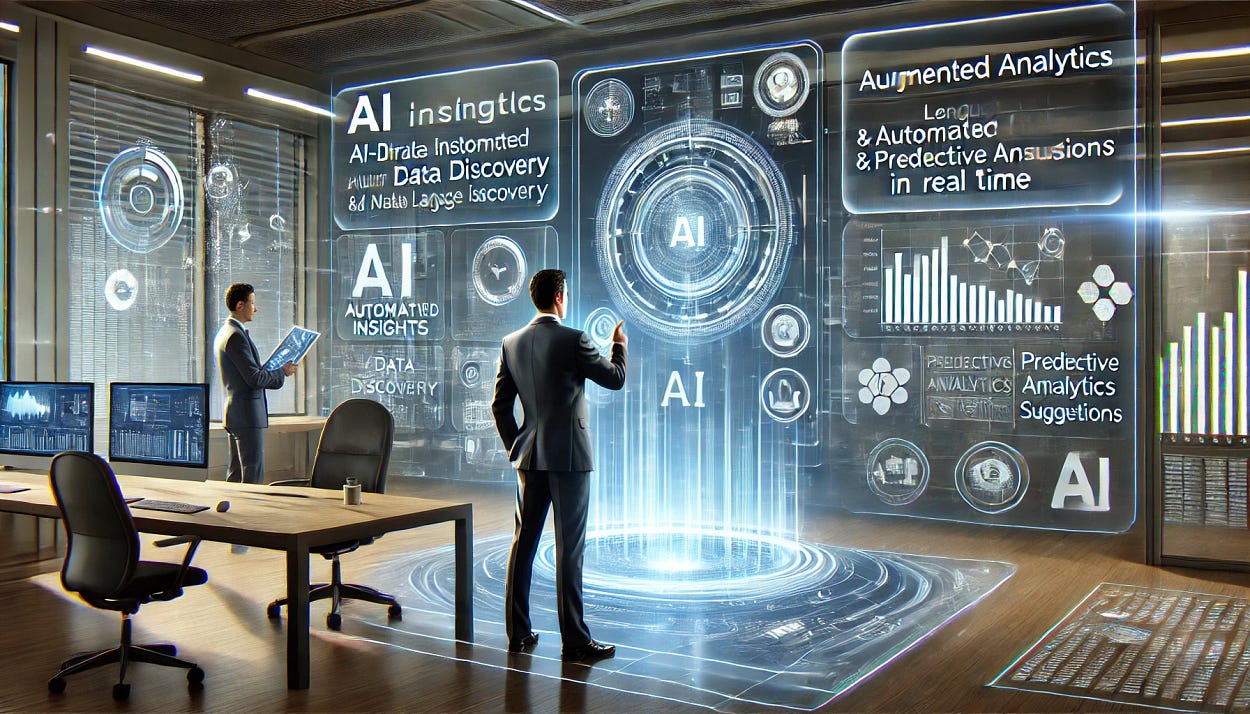Augmented Analytics: BI Meets AI (Today and Tomorrow)
Driving the Analytics of 2030, not 2020

The future of analytics isn’t just about better dashboards or faster reports — it’s about rethinking how we harness data to drive competitive advantage. In my full article, Driving the Analytics of 2030, Not 2020, I explored how organizations need to shift their mindset and strategy to keep pace with the evolving analytics landscape. This section walk through Augmented Analytics, uncovering key insights and practical strategies for forward-thinking data leaders.
Augmented Analytics is the infusion of AI and machine learning into the analytics process itself. Instead of just providing tools to make charts, augmented analytics features can automate insights discovery. Gartner heralded augmented analytics as “the future of analytics”, because it helps business people overwhelmed by data to find what truly matters. In essence, AI helps at each step: preparing the data, analyzing it for patterns, and even presenting findings in natural language.
Read more: [Gartner: Augmented Analytics is the Future of Analytics](<https://go.thoughtspot.com/analyst-report-gartner-augmented-analytics-li.html?utm_source=linkedin&utm_medium=paidsocial&utm_campaign=dec-19-gartner-augmented-lsn#:~:text=Analytics is at a critical,driven decisions)
For example, modern BI tools might allow you to ask questions in plain English (“What were our top 3 products by profit last quarter?”) and get an instant answer with a chart — that’s NLP in analytics. Or the system might proactively alert you: “Hey, this metric is unusual today and here are likely reasons.” One quote put it well: “Augmented analytics uses AI/ML to augment human intelligence, presenting the insights most important to them and driving data-driven decisions.”
Read more: [Gartner: Augmented Analytics is the Future of Analytics](<https://go.thoughtspot.com/analyst-report-gartner-augmented-analytics-li.html?utm_source=linkedin&utm_medium=paidsocial&utm_campaign=dec-19-gartner-augmented-lsn#:~:text=Analytics is at a critical,driven decisions)
By 2030, augmented analytics will be everywhere. Some concrete things to expect.
Automated Insight Generation
You open your analytics app and it already has a few headlines for you: “Sales in Region East are 5% above trend due to spike in Product Z sales to first-time customers.” This is the AI doing the first pass of analysis — scanning millions of data points and summarizing the “so what” for you. It’s like having a junior analyst always on duty, but one that works at machine speed.
Natural Language & Chat Interfaces
Instead of slicing data via mouse clicks, you might chat with your data: “AnalyticsBot, compare our Q1 customer acquisition cost across regions and tell me if anything stands out.” The bot could reply with text and charts, and you could drill down with follow-up questions. OpenAI’s GPT models are already being integrated into BI tools for this purpose. By 2030, talking to your data will be normal — even fun.
Decision Support Integration
Augmented analytics doesn’t stop at insight; it helps with decisions. This means integrating analytics into business processes. For instance, when making a pricing decision, an AI agent might pop-up in the pricing software saying, “Based on historical data and current demand, a price of $X is optimal for this deal (with 90% confidence).” It’s not making the decision, but it’s supporting it with on-the-fly analytics. Think of it as an AI consigliere whispering data-driven counsel in every manager’s ear.
Broader Adoption Beyond Analysts
The real promise is that anyone can leverage advanced analytics, even if they aren’t a data scientist. Augmented analytics, combined with easy UIs, means a marketing specialist can do customer segmentation with clustering algorithms without knowing the math, or an HR manager can forecast attrition without coding a model — the tools handle the heavy lifting. By reducing the skills barrier, organizations get more brains using data. In fact, the culture of data-driven decision-making truly flourishes when people at all levels can play wit.
Read more: [The Future of Data Analytics: Key Trends Shaping Innovation](<https://www.quadratichq.com/blog/the-future-of-data-analytics-ai-enhanced-insights-at-your-fingertips#:~:text=The success of data analytics,of organizations across every industry)
One emerging trend is the idea of the Analytics Catalog or Marketplace inside companies — by 2030, large enterprises might have internal “app stores” of data products. Employees could browse a library of AI-powered analysis modules (e.g., a “churn predictor” or “inventory optimizer”) and plug them into their workflow. This modular approach, paired with augmented analytics, could massively accelerate analytics adoption.
The path to 2030’s analytics landscape isn’t about incremental improvements — it requires bold rethinking and strategic transformation. In the next article, we’ll dive into AI Agents and No-Code Automation.